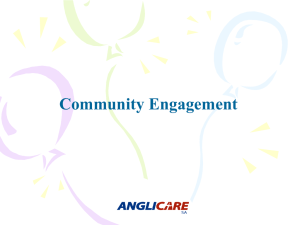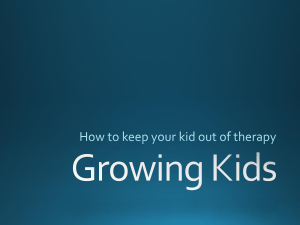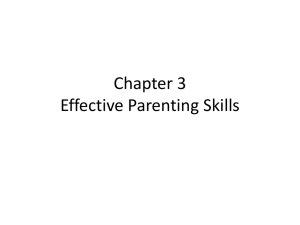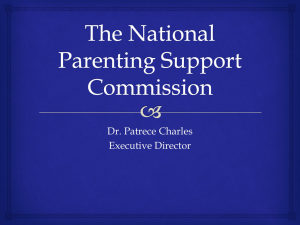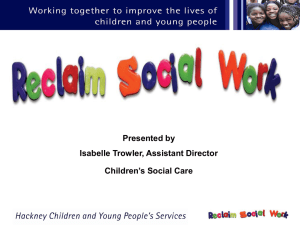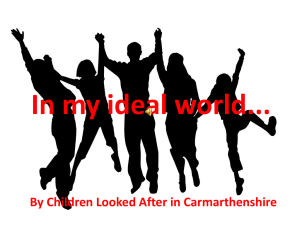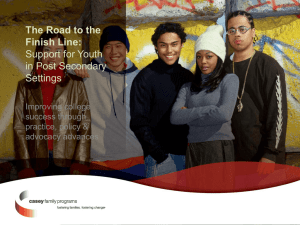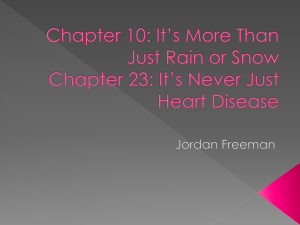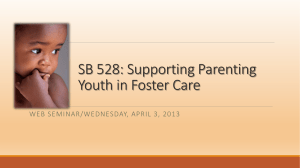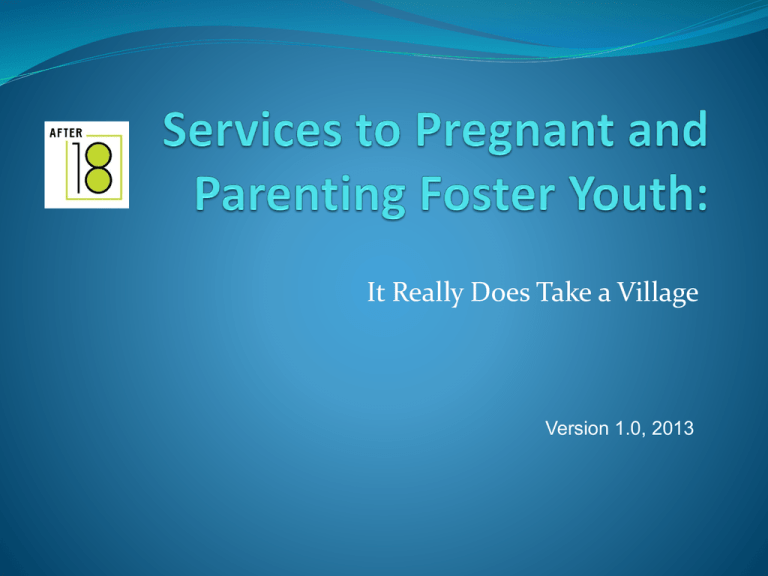
It Really Does Take a Village
Version 1.0, 2013
Agenda
Introductions / Learning Objectives
Video - A Crucial Connection
Prevalence / Statistics
Costs
Cultural Considerations
Relevant Research
AB12/Pregnant and Parenting Youth and Young Adults
Exercise / Communication and Assessment
Building Relationships with Pregnant and Parenting Foster
Youth
Lunch
Foster Alumni Panel
Placement and Caregivers
Closure
2
Introductions
Who are you and why are you here?
What are your interests and/or investments in learning
about this population?
3
Goals for Today
Develop a lens through which we can understand
behaviors of foster youth who are pregnant and
parenting
Enhance our understanding of pregnant and parenting
teens in the foster care population
To highlight and contextualize adolescent behavior
around issues of guilt, shame and fear
To review the goals and values of AB12 as it pertains to
these youth
4
Learning Objectives
Knowledge
K1. The trainee will be able to identify how foster care and pregnancy affect the
process of independence and emancipation.
K2. The trainee will recognize physical, physiological, and psychological
changes associated with pregnancy.
K3. The trainee will be able to identify special housing/placement needs of
pregnant youth, parenting youth with infants.
K4. The trainee will be able to identify practice behaviors that convey support
for dependent minor parents and non-minor dependent parents and young
adult parents (including parents who choose to leave care and parents who
choose to stay in extended care).
K5. The trainee will be able to identify strategies for improving placement
stability for pregnant and parenting teens, including tools to assist caregivers to
address the caretaking, safety, permanency and independence issues for
parenting foster youth and their infants.
5
Learning Objectives
Skill
S1. The trainee will be able to identify independence related
tasks and decisions associated with becoming a parent and
achieving parental competency as stated in case plan for
placement and/or for court if infant/toddler is a dependent.
S2. Trainee will be able to initiate discussions around mental
health and well-being pertinent to reproductive and sexual
health and safety, and to provide local referrals to appropriate
service providers.
S3. Trainees will be able to initiate discussions of well-being
pertinent to caregivers and assess the caregiver’s appropriateness
and comfort level in parenting and reproductive health
discussions with foster youth.
6
Video – A Crucial Connection
Debrief / Discussion
What surprised you on the video? Were you aware of
the size of the problem?
Does this video give you some insight regarding the
plight and perspectives of pregnant and parenting
teens in foster care?
7
Statistics and Prevalence- Data
Not a lot of county or state information regarding
foster youth who are pregnant or parenting
Issues around compilation of information, variety of
data sources, varied methodologies
More outcome information is available
Problems around age, information, sensitivity of
gathering information
8
Prevalence and Statistics- Samples
Who are the youth?
Young women who had been in foster care are more likely to
have been pregnant than same age peers who had not been in
foster care (Courtney et al, 2007)
How big is the issue?
Geographical
Age group peak
Cultural Issues
Trends by race
What about California?
Trends – age, race, SES
9
Statistics – California
As of July 2012, California has 60,230 children and
youth in state supervised foster care
In 2010, 43,149 babies were born to girls age 15-19 in CA
Of those, 7,517 were second or subsequent births
2010 CA teen birth rate:
Girls age 15-17 was 16.4 per 1000
Girls age 18-19 was 53.4 per 1000
10
Statistics – National
US birth rate for girls 15 – 17 (2010)
17.3 per 1000
US birth rate for girls 18- 19 (2010)
58.2 per 1000
11
Statistics by Ethnicity, Race
Pregnancy rates
Hispanic
African Am
Whites
125 per 1000
123 per 1000
43 per 1000
Birth rates
Hispanic
Afr. Am
Native Am
Whites
Asian/Pac Islander
62.9 per 1000
43.2 per 1000
24.2 per 1000
14.7 per 1000
11.7 per 1000
12
Why It Matters….
Taxpayer costs associated with teen pregnancy:
$1.127.6 million for California
$10 million - Nationwide
13
Key Research Reports and Findings
Chapin Hall at the University of Chicago (2002-2007)
Longitudinal survey of youth which gathered data at 3
time points (ages 17, 19 & 21)
Interviewed around issues of sexual behavior,
pregnancy, children and parenting
The Midwest Evaluation of the Adult Functioning of
Former Foster Youth (Midwest Study)
14
Key Research Reports and
Findings – Chapin Hall (2)
17 y.o. – almost twice as likely to ever have been pregnant
(33% vs. 19%)
19 y.o. – nearly half of the young women who had been
in foster care reported having ever been pregnant,
compared to 20% of their peers
21 y.o. – 71% of young women had ever been pregnant, as
compared to 34% of their peers
15
Key Research and Findings –
UCAN and National Campaign (3)
UCAN and National Campaign to Prevent Teen and
Unplanned Pregnancy – Fostering Hope
Mixed method study
Foster youth often had mixed emotions including wanting to
continue their education while wanting to establish a family
by having a baby (Love et al, 2005)
Youth cited embarrassment, foster parents not bringing up
the subject, lack of trust in foster parents and a desire to
receive more personal attention around these issues
Substantial number of programs for pregnant and
parenting teens did not have a specific plan for assisting
adolescent to avoid a subsequent pregnancy
16
Key Research and Findings (4)
Public Health Institute Study (2009)
Wanted to look at the sexual/reproductive health needs
and challenges of foster and transitioning youth in CA
Large number of staff believed that adolescent
pregnancy was largely accepted in the youth’s family of
origin and by peers
Unmet needs for love and belonging by foster youth
History of sexual abuse may create increased
vulnerabilities
Having knowledge does not imply using knowledge
17
Key Research and Findings (5)
John S. Burton Foundation report highlighted current
unmet needs of parenting young adults and proposed
recommendations to address them
Proposed 6 policy recommendations:
1)
2)
3)
4)
5)
6)
create a digital clearinghouse of information
periodic screening of pregnancy and parenting needs
Expand nurse-family partnerships
exclude foster care payments from child care subsidy
calculations
create a statewide child care program for parenting foster
youth
give parenting young adults priority housing access
18
After 18 Goals
Establishing connections
Achieving permanency and stability
Moving toward competence and independence
19
After 18 Values
Voices of Young Adults
Assistance and Partnering
Love and Belonging
Unique Needs
Eligibility is Maintained
Development is Supported
20
Applying After 18 Goals and Values
At each table, discuss how the social worker might put
these values into action when working with pregnant
and parenting teens in an out-of-home care setting?
In other words, how might you demonstrate these
values when working with these youth?
Remember to keep the goals of After 18 and ASFA in
mind…
21
Pregnant and Parenting
Foster Youth
Discussion - How might the services and supports
differ for foster youth and young adults who are
pregnant and parenting?
22
Communication and Adolescent
Youth Culture
Foster youth and relationships
Characteristics of peer and romantic relationships
Adolescent youth culture in general
Initiating and maintaining open communication
Establishing a relationship
Trust
Purpose of the communication
Difficult Messages
Results
23
Coping In The Caseload
The Talk
Avoidance
Passing the buck
Elephant in the room
24
Some Acknowledgements
Not an easy population to communicate with due to
generation gap, other factors (misunderstanding, stigma,
judgment)
Key: Listen for pain, fear
Seek to hear and understand, use active listening skills
Social workers may be biased, judgmental
Pre-conceived notions or history
Foster youth may be biased, judgmental
Pre-conceived notions or history
History may be an obstacle to communication – try to chip
away at this by establishing trust
How do we do this? Return calls, establish a relationship via
best practices
25
Preparation for the Panel
Questions –
Use index cards
Concerns
26
Young Adult Parent #1
27
Young Adult Parent #2
28
Young Adult Parent #3
29
Case Management Considerations
Case Management - Working with Caregivers and
Pregnant and/or Parenting Teens
30
Assessments –
Parental Readiness and Safety
Handout – Review
Discussion
31
Placement Considerations – Shared
Living Arrangement
Household Values
Household Composition
Accommodation and considerations
Shared living arrangement
Education
Caregiving for the Infant/Toddler
Child Care
Transportation
Employment/Training/School/College
32
Working With Caregivers
Caregiver characteristics
Communication Style
Strength-based
To avoid miscommunication, be direct, use open-ended questions
Use probing questions to understand complexities
Caregiver Temperament
Is caregiver temperament a fit for the youth, given youth behavior,
background, presentation?
Explore caregiver biases
Caregiver Experience
Has this caregiver fostered teens?
Does this caregiver demonstrate tolerance for adolescent behavior
Has this caregiver fostered teen parents? Infants?
33
Exercise
Developmental Issues of Adolescence vs. Impact of
Pregnancy and Parenting
34
Closure and Evaluations
Taking Stock of Learning Objectives
Directions for Further Exploration
Evaluation
35
Thank You!
36

